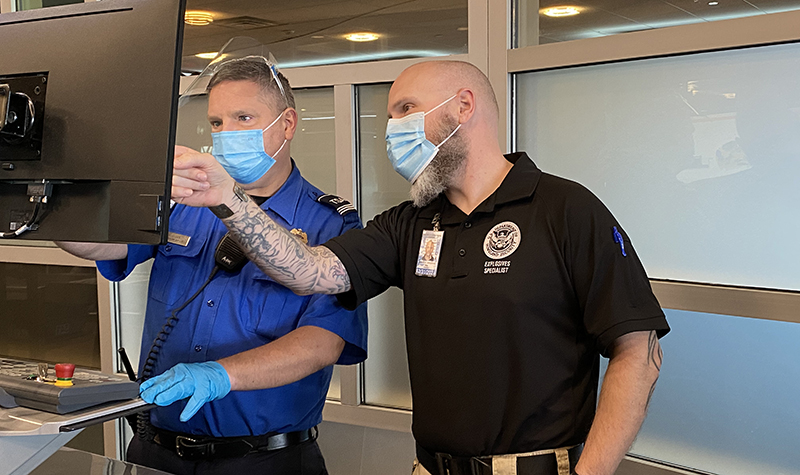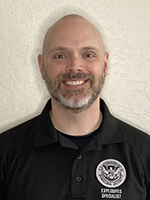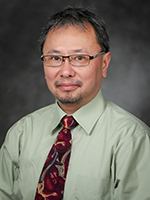Two birds, one stone: UND’s IDT program shows impact
Federal TSA explosives specialist excels in Instructional Design & Technology program to national acclaim

In 2018, Shane Langerud arrived in his home state of North Dakota ready for a second career.
After 21 years in the U.S. Marine Corps as an Explosive Ordnance Disposal (EOD) bomb technician, Langerud leaped at the chance to become the Transportation Security Administration’s lead explosives specialist for the state.
In early December, Langerud was recognized as 2020’s Transportation Security Specialist for Explosives of the Year. According to the TSA’s announcement, the award “recognizes the top technical expert on improvised explosive devices and other threats to transportation security.”
Langerud was the only such specialist in the country to receive the award last year, and he attributes a portion of his national recognition to what he’s learned at UND.

Langerud’s extensive EOD background means he spends much of his time training TSA officers in what threats to look for. Before coming to the TSA, he had already earned a doctorate in management, and Langerud worked as a trainer for much of his career.
But, at UND, he found a path to excel even further in his profession.
At the College of Education & Human Development, in the Instructional Design & Technology (IDT) master’s program, the TSA’s top explosives specialist is learning how to better train North Dakota’s officers in a way that directly impacts his task of keeping the skies safe.
One reason lies in the distinction between being a subject matter expert (i.e., the expertise Langerud developed as a bomb technician in the Marines) and being a training expert, as the TSA now wanted him to become. “Many people are surprised to learn that training is its own field and requires specific expertise,” said Richard Van Eck, associate dean for teaching and learning at the School of Medicine & Health Sciences and former graduate director for the IDT program.

“Conventional wisdom is that if you know something, you can teach it,” Van Eck said. “Professionals like Shane – who’ve developed great expertise – are often asked to train others, and quickly learn that is not true. IDT programs are full of highly trained professionals who want to learn how to train others to be just as effective.”
In addition to gaining expertise in teaching and learning, the IDT program has also been effective for Langerud because of its focus on project-based learning. “It is the greatest arrangement ever,” said Langerud, a Fargo native. “In every course of this program, I can apply the projects I’m doing to my job. I’m at work, doing schoolwork, and the two are directly tied.
“My goal has been to develop trainings that are engaging for my officers, and I’ve been able to do that with the knowledge I’ve picked up in this program.”
By professionals, for professionals
According to Woei Hung, professor and graduate director of UND’s IDT program, Langerud’s case is but one example. All of his students are engaged in project-based courses that can immediately affect their external, professional contributions, Hung said.

This fact applies not only to the two master’s degree tracks, but to the program’s multiple certificate-level offerings as well.
“Our program is built upon learning sciences,” Hung told UND Today. “We study how people learn and how the human brain works. Then, using that knowledge, we develop instructional principles and theories that then shape how we design learning materials.”
Hung emphasizes the action-oriented approach of his courses when discussing the IDT curriculum. Theories provide an essential foundation, but Hung’s objective is to have his students work through real-world circumstances as often as possible, acting on empirical evidence and research data through the best techniques and technologies available.
Van Eck shares this vision, and adds that all IDT students are current professionals in K-12/higher education, health care, military, government and corporate sector fields.
Tools at his disposal
For Langerud, a case in point regarding project-based learning was when he was working through a course called Introduction to Computer-Based Instruction. In learning how to create learning materials using certain pieces of software, Langerud found himself using Adobe Captivate – an authoring tool specifically designed for computer-based learning.
“By the end of the course, moving from one assignment to the next using Captivate, I had built my own lesson that I wanted my officers to take,” Langerud said. “And I’m implementing these lessons on the job as I go through the program.”
Langerud said his UND work takes on a “two birds, one stone” approach that ultimately benefits his officers stationed at North Dakota’s eight federally secured airports. Langerud uses all of the tools at his disposal to help the TSA better identify explosives, components for creating improvised explosive devices and other potential threats to flight safety.
In addition to the virtual lessons he’s creating as part of his UND education, Langerud also spends time working on in-person trainings, creating realistic training aids (such as test bags), and developing ways of helping officers understand the potential threats passing through security checkpoints. His other responsibilities include advising the state’s federal security director and staff, as well as responding to notifications of potential threats.
Educating for safer skies
What stands out about Langerud’s work in the classroom is how well he knows his audience, because “one size doesn’t fit all, when you design instruction,” Hung said.
“You need to understand your audience, in many respects, in order to keep them engaged,” Hung continued. “Shane knows the formats that not only keep the attention of his students, but also what works well for officers’ varying schedules.”
That’s easier said than done. The state’s TSA officers range from college to retirement age, from GEDs to master’s degrees, and so on, Langerud said. Thus, he relies on his ability to break lessons down to the “bare bones,” keeping language plain, but lively.
“Fortunately, the topic in and of itself is engaging, because it’s explosives we’re talking about most of the time,” Langerud remarked. “Who doesn’t love to learn about stuff that goes boom?”
But, of course, it’s serious business. In Langerud’s words, the TSA needs to correctly assess threats 100 percent of the time. The bad guys need to be right only once.
Last year’s Explosive Specialist of the Year offered great praise for his superiors, who give him as much latitude as he needs to effectively train the state’s TSA agents. “They’re telling me, ‘Keep doing what you’re doing, because we’re getting great feedback from the officers, and that’s all that matters,’” Langerud said.
2020’s elephant in the room, the coronavirus pandemic, hit Langerud as a trainer at what turned out to be a good time, as he was already deep in his Master of Education track in the IDT program.
“With this program, I’ve now been able to develop trainings, disperse it out to everybody and get people trained even though I’m not physically at that location,” Langerud said. “Then, whenever I make it out to a particular airport, I’m able to go over the same lessons with training aids, to see what officers have retained.”
Opportunities for further excellence
As COVID has radically shifted workplaces and learning through the past year, Hung sees ample opportunities for the IDT program to help educators and professionals alike fill in the gaps, particularly at UND.
“I see great opportunities for faculty and staff on campus to take some instructional design courses,” Hung said. “I believe that can directly translate to an increased quality of instruction, training and engagement across campus.”
Kathleen Kittridge, a career coach at the Nistler College’s Pancratz Career Development Center, was especially interested in learning how to engage remote and online learners.
“I was only vaguely familiar with instructional design, and I thought the IDT certificate program would be a great opportunity to learn a new set of skills that could help me better serve UND students, as well as my own professional development,” Kittridge said.
She shared that she has learned how to be more intentional and creative when developing educational resources, by way of the program. And by the time the Fall Accounting Career Fair was moved to a virtual format last year, Kittridge was better equipped to create a training video for students to learn the Handshake platform.
Both Langerud and Kittridge stressed the value of the IDT program’s learning community in their pursuits.
“Coming from programs that have all been asynchronous, it has been nice to engage with peers in class and pick up on what techniques or applications they’re turning to on the assignments,” Langerud said. “I’ve been able to learn almost as much from the cohort as I have from the program.”



